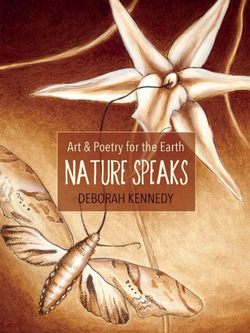Читать книгу Nature Speaks - Дебора Кеннеди - Страница 10
На сайте Литреса книга снята с продажи.
ОглавлениеIntroduction
This book reflects my ongoing artistic journey that has taken me from working with large-scale installations and paintings to expressing myself with the writing and illustrations of this book. My early installations and objects drew on social and political themes, including human rights and censorship. In 1989, just before the Berlin Wall fell, I created a series of installations on its surface. These installations included Writing on the Wall, in which I gathered hopes and fears from people in West Berlin, East Berlin, and the United States, inscribed these statements on metal plaques, and mounted them on the Wall. Writing on the Wall allowed the inner thoughts and feelings of people from both sides of Berlin and from both sides of the Atlantic to communicate together on the Wall. This work garnered considerable attention and was featured in newspapers and books.
In the early1990s I created Ecotech, a public artwork for a new transit line in San Jose, California. In my research for this project, I became fascinated with efforts to reform our technological systems and manufacturing so they function in biocompatible ways. With Ecotech, I had found a way to express my abiding concern for the natural world through my artwork. Since then, my work has primarily explored environmental subjects. My conceptually-based work begins with questions: What new ways of thinking can help us solve our environmental problems? How is exposure to toxic chemicals affecting the health of human and animal populations? How are birds, butterflies, and amphibians faring in our increasingly technological world with its burgeoning human populations? Researching these questions is the way I discover the ideas, images, and materials that inform and inspire my work.
In 1999, I created a show entitled Nature Speaks for the de Saisset Museum. The exhibit featured three large-scale installations and the work was very demanding. While also teaching, and raising a young child, I did most of the considerable labor myself. People appreciated the show, and the work seemed to have an impact on my community. Artweek, a regional art magazine, published a review and an interview with me about this work. Overall, however, the impact did not seem commensurate with the effort.
This exhibition spurred me to evaluate my role as an artist. I wanted to express myself in a new way that would speak more directly about my ideas and feelings. The condition of the natural world and the threats to human health are at a critical juncture today. To express myself in the most powerful way I could, I began to write poems. This choice may seem paradoxical, but I believe poetry has a secret power. As a society we often seem largely unmoved by our environmental challenges despite many rational arguments. Poetry speaks through metaphors which can move our hearts, and then our brains. Therefore, I began writing about these themes, and my experiences with the natural world, and found this work deeply satisfying.
After several years of working on these poems, I decided to create a pen and ink illustration for each one, a new discipline for me. Some of these illustrations required up to 40 or more hours of work. I found the long process of gradually building up gradations in value and defining the forms both meditative and enjoyable. My drawings frequently illustrated a metaphor or an image in the poem, and I approached each one anew, creating images that vary from realistic to surreal. I used earth-toned inks like burnt sienna, originally made of specially colored soils and sepia inks to create these drawings and am enamored of their deep, warm browns. Sepia ink, originally made from the ink of cuttlefish, often appears in the first European landscape drawings.
After completing several illustrations, I began to experiment with wet-into-wet techniques, where ink seeps and spreads in water on the surface of the paper. I also started to use spattering, where little drops of ink are sprayed at the image, often requiring detailed masks. These techniques recall the Dadaists’ and Surrealists’ experimentation with “chance operations,” such as squishing paint between two surfaces to develop patterns with little artistic control. The Surrealists felt these techniques allowed the randomness of the real world to enter into their artwork. Their use of “chance operations” often affronted traditionalists who emphasized using the skillful artistic techniques found in academic European art. For me, these techniques suggest today’s increasingly unpredictable world and the uncontrolled movement of unseen materials throughout the environment.
My experience as an artist has affected my writing beyond creating the illustrations. I have worked on these poems for many years, shaping and honing them countless times. This reminds me of the many stages of alabaster stone carving. I start with a hammer and a steel tool called a point to rough out the shape, and next move to stone chisels and claws to start refining the form, followed by files and coarse rifflers, which look like small, shaped files. These rifflers help refine the final shapes. Polishing requires six grades of sandpaper, each worked methodically over the entire surface. This sculptural process informs my writing-working and reworking the poems, seeking the essential story, the right tone, image, and word.
By publishing this work, I hope to help confront our troubled relationship with the natural world and support the growing edge, where we, as a global community, can create new visions that will help solve our environmental problems. By changing our beliefs and behaviors as individuals and communities, we can restore and regenerate our planet.
